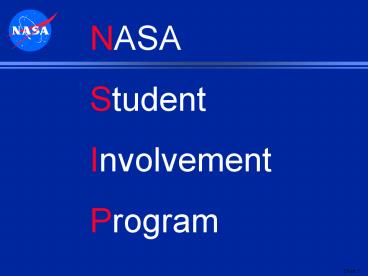NASA PowerPoint PPT Presentation
1 / 16
Title: NASA
1
NASA Student Involvement Program
2
NSIP
- National Program awarded to the National Space
Grant Foundation and Universities Space Research
Association (USRA) - Dr. Erian Armanios, Georgia SG - PI
- Mary Sandy, Virginia SG Co-I
- NSIP Program Manager and Co-I USRA
- Six challenges linking K-12 students to NASA
missions and research - Current revised budget is 67 of proposed budget
3
Six Challenges for Grades K-12
My Planet, Earth
Aerospace Technology Engineering Challenge
Science Technology Journalism
Watching Earth Change
Design a Mission to Mars, And Beyond
Space Flight Opportunities
4
NSIP Competition Details
5
My Planet, Earth
K-4 grade students and educators conduct a study
of a local site, describing and illustrating
their observations, making measurements, and
looking for interconnections.
Sample Student Drawings
6
Science and Technology Journalism
K-12 grade students choose a newsworthy topic
about the years theme, research the topic, and
produce a print or video story.
Examples of Spinoff Technologies
7
Aerospace Technology Engineering Challenge
5-8 grade students design, test, and redesign
part of a rocket using everyday materials.
Thrust Structure Design Process
8
Design a Mission to Mars, And Beyond
5-12 grade students identify a research question
and design a lunar-based mission to Mars to
answer that question.
NSIP students using maps and images to design a
mission.
9
Watching Earth Change
5-12 grade students analyze NASA and other data
to investigate how Earth changes over time.
Sample NASA data to be analyzed
NSIP students measuring local conditions to
compare with NASA data
10
Space Flight Opportunities
9-12 grade students design experiments to fly
onboard a NASA sounding rocket or or other
experimental flight opportunity!
NSIP students and NASA engineer preparing
sounding rocket for flight
11
NSIP SG 8 Regional Leads
- Georgia SG
- AL, FL, GA, MS, SC, PR, VI
- Pennsylvania SG
- CT, ME, MA, NH, NJ, NY, PA, RI, VT
- Virginia SG
- DE, D.C., DoD, KY, MD, NC, OH, TN, VA, WV
- Texas SG
- Colorado SG
- Washington SG
- Montana SG
- Iowa SG
12
SG Regional Coordinators Role
- Point of Contact for your state teachers and
schools - Point of Contact for Regional States
- Program Dissemination and Marketing
- Screen entries for compliance
- Coordinate judging for state and regional awards
- Coordinate award programs for winning schools
13
NSIP Each Space Grants Role
- Assign designated NSIP coordinator
- Ensure dissemination of opportunity
- Increase participation
- Maximize participation of underrepresented and
underserved populations - Ensure knowledge of program and assist teachers
in defining projects (promote resource guides) - Coordinate speakers and presentations for awards
- Submit brief report
14
NSIP Awards
- State Winners
- 1st, 2nd, and 3rd for each competition in each
state - Regional Winners
- 1st, 2nd, and 3rd for each competition in each of
8 regions - Plaque presented by NASA representative
- National Winners
- For each competition
- G 5-8 Space Camp for 4 students
- G 9-12 NES Symposium (2 students 1 teacher)
- Space Flight (Student flight week 2 students 1
teacher)
15
Virginias Marketing Targets
- Previous participants
- DOE Contacts
- Science, English, Math, and Technology Education
- NASA Centers Goddard, Langley, Wallops
- Education Directors AESP Personnel
- Solar System Ambassadors
- Va. Association of Independent Schools
- SERCH and MARSBB
- YMCA, Rec Centers, Boys and Girls Clubs
- Home School Students
16
Important Notes
- Entry deadline January 31 (Space Flight Jan 15)
- Increase participation (1,500 entries and 3,300
students in 03-04) - Maximize participation by underrepresented
minorities - Website up by end of Sept
- Participating school lists distributed to SG
Regions first of next week

